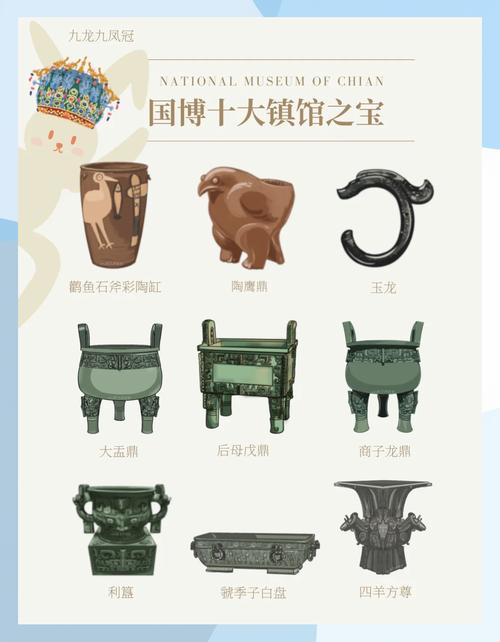Sistertours.com ! WeChat/WhatsApp: +8613811531028
The National Museum of China's ten most prized artifacts span a wide range of periods from the Neolithic Age to the Ming Dynasty, including bronze ritual vessels, painted pottery, and jade artifacts. They are microcosms of civilizations from different historical periods. Below is an English description combining the characteristics and historical value of these artifacts:

1. Houmu Wu Cauldron
It is a bronze ritual vessel from the late Shang Dynasty, unearthed in Wuguan Village, Anyang, Henan Province in 1939. With a height of 133 cm and a weight of 832.84 kg, it is the heaviest bronze artifact known in ancient China. The inner wall of the cauldron is inscribed with the characters "Hou Mu Wu". Decorated with imposing taotie patterns and sturdy pillar - shaped legs, it was cast in one go, fully demonstrating the highly sophisticated bronze - casting technology of the late Shang Dynasty and is hailed as a top - tier national treasure.
2. Four - Sheep Square Zun
Unearthed in Ningxiang, Hunan Province in 1938, this is a renowned bronze ritual vessel of the late Shang Dynasty. Standing 58.3 centimeters tall, it is the largest existing bronze square zun from the Shang Dynasty. A lifelike curled - horn sheep head is carved at each of the four corners of its shoulder. It integrates multiple crafting techniques and is covered with exquisite cloud - thunder and beast - face patterns. It is praised by the academic circle as the "ultimate model of bronze art".
3. Zilong Cauldron
As the largest existing bronze round cauldron of the Shang Dynasty, it was unearthed in Huixian County, Henan Province in the 1920s. After being unearthed, the cauldron was scattered overseas and once flowed to Japan, then later transferred to Hong Kong. It finally returned to the motherland in April 2006. Its majestic shape and delicate decorative patterns mirror the superb bronze - casting level of the late Shang Dynasty, possessing inestimable artistic and historical value.
4. Great Yu Cauldron
This bronze vessel dates back to the reign of King Kang of the Western Zhou Dynasty and was unearthed in Licun, Mei County, Shaanxi Province in 1849. There are 291 characters of inscriptions cast on the inner side of its belly, which record the teachings and rewards that King Kang bestowed upon his minister Yu. These inscriptions are not only precious materials for researching the history of the Western Zhou Dynasty but also hold significant value for the study of the calligraphy art of that period.
5. Li Gui
It is an early Western Zhou Dynasty bronze artifact, unearthed in Lingkou Town, Lintong District, Xi'an, Shaanxi Province in 1976. The artifact is 28 centimeters tall, with an upper circular and lower square structure, a typical shape of bronze gui in the early Western Zhou Dynasty. The inscriptions cast on the inner bottom record the major historical event of King Wu's campaign against King Zhou of Shang, which confirms the relevant records in *Records of the Grand Historian* and serves as the unique physical evidence of the Battle of Muye.
6. Guoji Zibai Basin
It is a bronze water - holding vessel from the period of King Xuan of the Western Zhou Dynasty and was unearthed in Baoji, Shaanxi Province in the late Qing Dynasty. The inner bottom of the basin is inscribed with 111 characters, which detail the deeds of Guoji Zibai leading his troops to defeat the enemy and being rewarded for his military achievements. The font of the inscriptions is upright and elegant, making it a model work in bronze inscriptions and highly valued in the field of calligraphy research.
7. Painted Basin with Human - Fish Motifs
Unearthed in Banpo, Xi'an, Shaanxi Province in 1955, this is a painted pottery work of the Yangshao Culture in the Neolithic Age. Contrary to its name as a "basin", it actually served as a coffin cover for children at that time. The basin is decorated with distinctive human - fish combined patterns. As one of the most exquisite artifacts with human - face motifs found so far, it is a representative work of Yangshao painted pottery craftsmanship, reflecting the unique aesthetic taste and primitive beliefs of the Neolithic people.
8. Jade Burial Suit Sewn with Gold Threads
Unearthed from the No. 40 Han Tomb at Bajiaolang Village, Dingzhou City, Hebei Province in 1973, it is a high - grade burial garment in the Han Dynasty. The whole suit is composed of various shaped jade pieces connected by gold threads. In the Han Dynasty, people believed that jade could keep the corpse from decaying, so this kind of jade burial suit was used for the burial of nobles. Its elaborate production showcases the superb jade processing and gold - making technologies of the Han Dynasty.
9. Hongshan Jade Dragon
This is a relic of the Hongshan Culture in the late Neolithic Age, unearthed at the Hongshan Site in Chifeng, Inner Mongolia in 1971. Carved from dark green serpentine jade, the jade dragon is in a coiled "C" shape and is 26 centimeters tall. Known as the "First Dragon of China", it is an important physical evidence of the dragon totem worship of ancient Chinese ancestors and has also provided strong support for pushing back the timeline of Chinese civilization.
10. Nine - Dragons and Nine - Phoenixes Crown of Empress Xiaoduan of the Ming Dynasty
Unearthed from the underground palace of the Ming Dingling Mausoleum in Beijing in 1957, the crown's frame is made of lacquered bamboo strips. Its main body is decorated with nine golden dragons and nine golden phoenixes, inlaid with 115 unprocessed natural rubies and 4,414 pearls. It adopts complex techniques such as kingfisher feather inlay. It is not only a magnificent imperial artifact but also a masterpiece that reflects the peak level of handicraft technology in the Ming Dynasty.